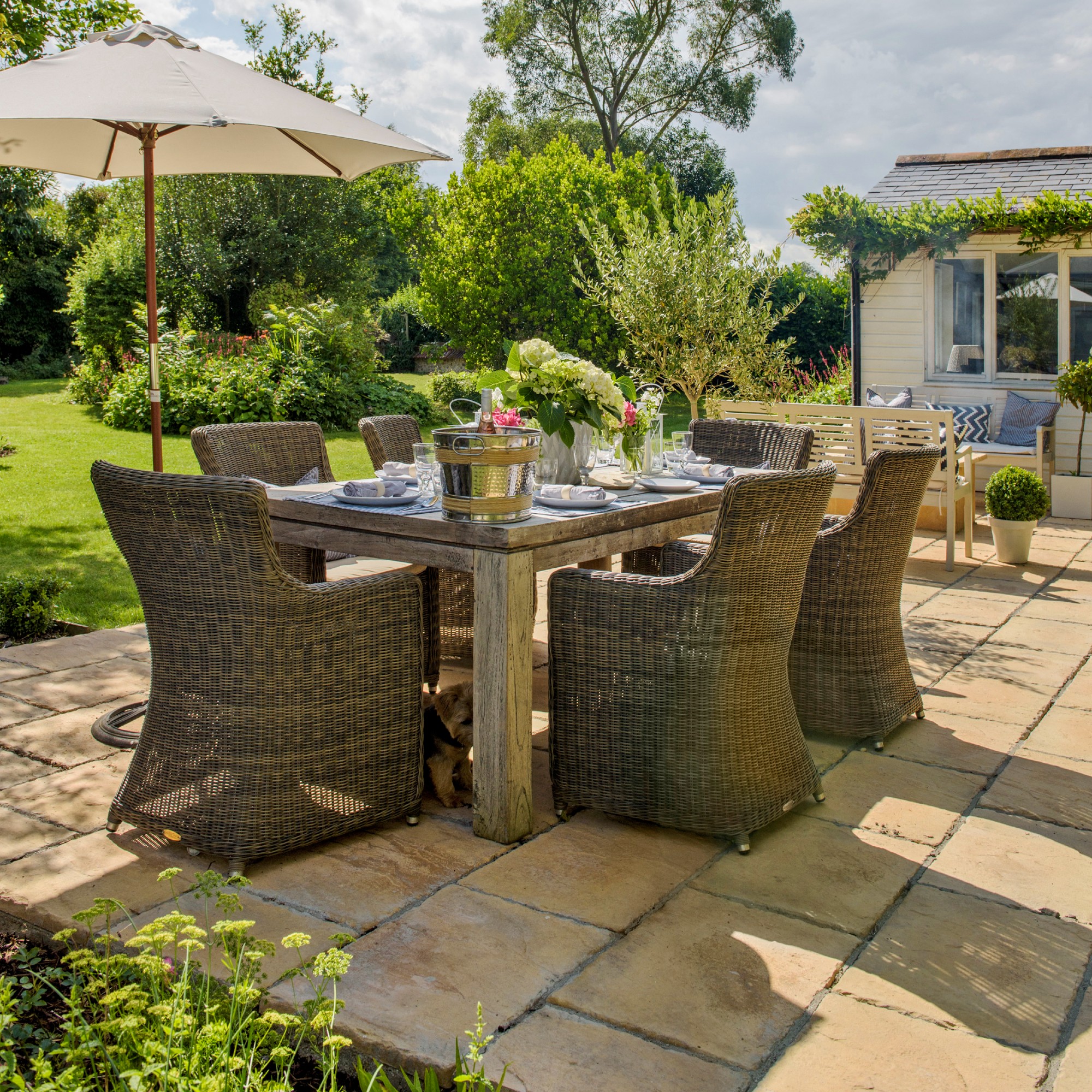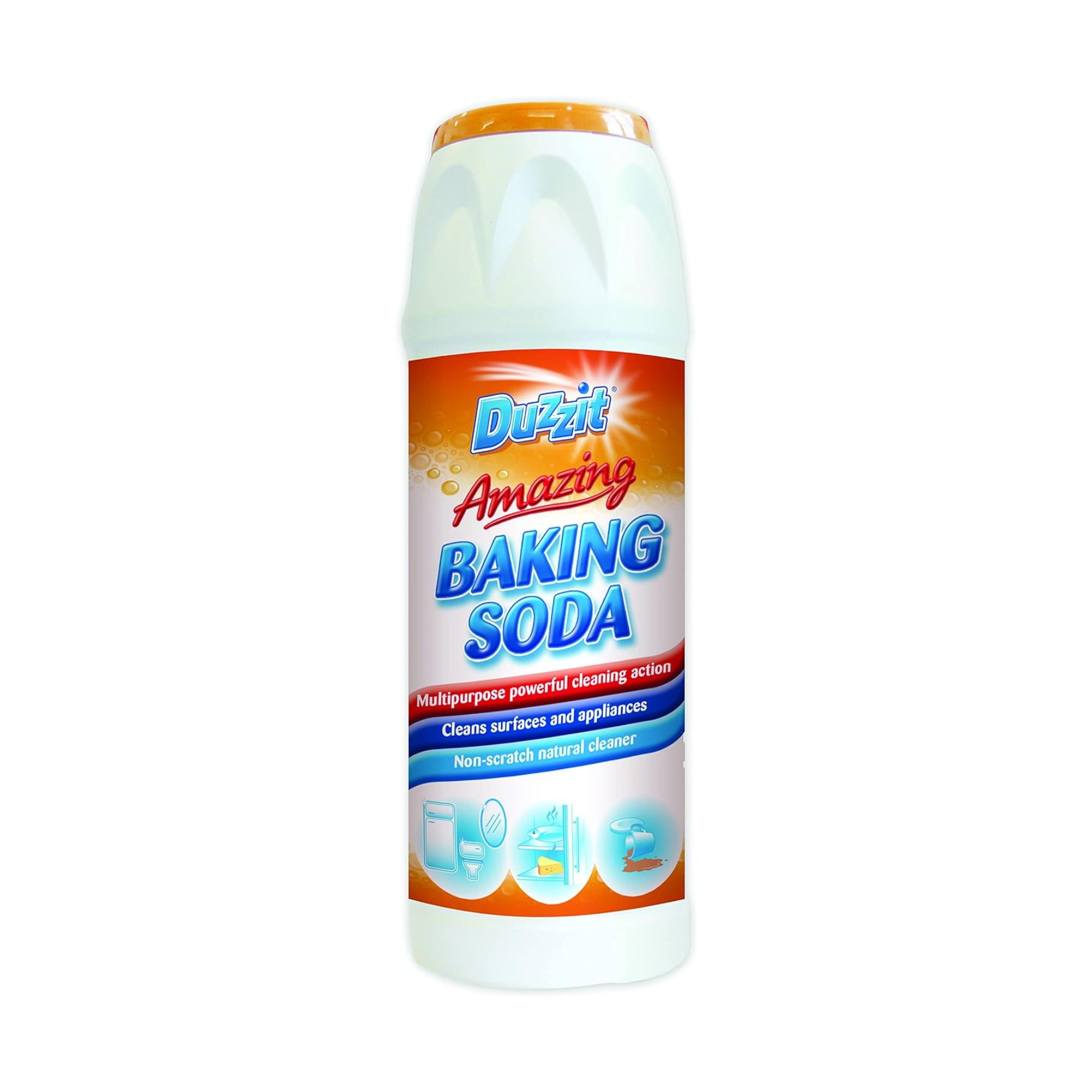How to remove black spots on a patio and stop them coming back, according to experts
Get rid of mould and mildew on your patio in six simple steps


If you’re looking at your patio and noticing the tell-tale signs of mould, mildew, and lichen, you’re probably wondering how to remove black spots on a patio. After all, this biological growth on your slabs and stones can be a real eyesore.
Yes, nothing ruins a patio idea quite like these black spots. What’s more, they often linger even after you’ve used the best patio cleaner to clean your patio. And when you’ve put blood, sweat, and (sometimes) tears into this task, it can feel as if these remaining black spots are taunting you. You don’t need to worry, though, as they don’t have to be there forever.
Thankfully, it is possible to remove black spots on a patio if you know how. That’s why we’ve reached out to experts to understand what causes this growth and how you can get rid of it for good.

What you'll need

This non-bleach formula is ideal for cleaning any type of patio surface. Sophie King, our Gardens Editor, tried this product out for herself and couldn’t believe how effective it was at getting rid of black spots on her driveway and garden path.
Step-by-step
1. Prep the area

There’s no point in trying to remove black spots on a patio if your patio is dirty and covered in debris. You need to be able to see the specific areas you want to target, so prep the area before you get started.
And while you may assume that using one of the best pressure washers is the right tool for the job, Martin Beaumont from Monty Miracle advises against it. He even says that pressure washing a patio with black spots can actually make the problem worse.
He says, ‘Every time you do this, you will be putting your surface under more pressure - eroding the top layer of the stone, blasting away render and exposing your patio or driveway to weather conditions in a short amount of time, which will reduce its lifespan.’ So, opt for the old-school cleaning method instead and grab your brush to sweep away any debris.
Dirt, gravel, leaves, and anything else that likes to find a home on your patio needs to be removed before moving on to the next step. Make sure to clear the space of any plant pots or garden furniture, too.
Sign up to our newsletter for style inspiration, real homes, project and garden advice and shopping know-how
2. Choose your cleaner

Black spots show up on patio slabs when mould and algae have taken root in the pores of the flags. So, you need to choose a cleaner that will get deep into the stones while being gentle.
There are plenty of mould-removing patio cleaners on the market – just double-check that they're safe to use on your patio's material. Jonathan Kirby, garden expert at Roxil, advises, ‘Watch out for acid or bleach-based cleaners as these can damage the patio surface, and instead opt for a soft, non-destructive patio cleaner.’
Martin suggests using the Monty Miracle Fast Patio Cleaner from Amazon as he says, ‘ It was created to deep clean a number of surfaces without damaging them. It’s biodegradable and has been specifically designed to remove black spots, algae, lichen and other organic stains from outdoor surfaces.’

Dr. Jonathan Kirby is a developmental chemist at Roxil, Safeguard Europe. From pest control to masonry protection, he has dedicated himself to helping protect UK housing stock through the development of new and innovative materials. Jonathan is the go-to garden expert at Roxil for tips on how to protect garden patios, paving and outdoor wooden structures from the elements.
3. Or, make a natural cleaning solution
Although you can use dedicated patio cleaners to remove black spots on a patio, there are always many natural cleaning hacks you can use, too. In fact, you probably have many options in your cupboards already.
One of the most popular ways to get rid of black spots on a patio is cleaning with vinegar or baking soda. These are powerful cleaning agents that help to decompose bacteria, and they work wonders for removing mould and mildew from outdoor cushions. Experts say they can do the trick for the patio as well.
'You can remove black spots easily from patios in an eco-friendly, low-cost way with white vinegar,' says Laura Harnett, Founder of Seep. 'It has antifungal and antibacterial properties and will also stop the mould or lichen from growing back. Mix a paste in a bowl using one part baking soda, one part white vinegar and one part hot water.'
If you don’t have any vinegar or baking soda lying around, you could also use washing powder that you’d use to clean your clothes. Although you can use either non-bio or bio, biological typically works best.
To use this, all you need to do is mix washing powder and warm water into a bucket and then use a brush to rub it onto the black spots. If you leave it for a few hours and then rinse off, you should find that the black spots on your patio have disappeared.
4. Apply your cleaner

When you’ve chosen the cleaning agent you want to use, you can then apply it to your patio. Be generous during this step, as the more solution you apply, the more likely those black spots will lift.
Wait at least 15 minutes before moving on to the next step to allow the solution to work its magic, but always consult your specific product before rinsing it off. Special patio cleaners may need longer to activate, with some products recommending you wait 24 hours before scrubbing, so check the manufacturer label after you apply.
Jonathan also adds, 'Wear gloves to protect the skin and then apply the cleaner with a spray or wire brush, either neat or diluted depending on the size of your patio.’
5. Scrub it
In most cases, pouring your cleaning agent over the black spots on your patio won’t be enough to get rid of them. So, you need to give it a scrub.
'Grab a stiff-bristled brush and scrub the black spots,' says Sarah Clemence, cleaning blogger at Busy Blooming Joy. 'Put some elbow grease into it, and you'll see them start to disappear.'
How much scrubbing you need to do will depend on how many black spots are on your patio and the type of cleaner you're using. Some patio cleaners will do most of the work for you, and you may find after leaving it to sit on your patio for 24 hours that most of the black spots have lifted.
If you’re unsure how long to leave it and how hard to scrub, focus on a small patch of your patio to see how it’s getting on.
6. Rinse away

When you’ve done the above, you probably want to see whether you’ve successfully got rid of the black spots on your patio or not. So, the next step is to rinse away the cleaning agent with fresh water.
'Finally, rinse the area with water, either with a hose or a low-pressure setting on one of the best pressure washers – high pressure might damage the pointing between slabs,' says Sarah.
As your cleaning solution washes away, the black spots on the patio should disappear with it. You may need to repeat the process for stubborn spots which have settled on your patio for a while. Then, wait for the patio to dry.
Martin also adds, ‘Once the area is dry, applying a sealer will extend its lifespan further.’ Something like this Sika Patio Seal Paving from Amazon should do the trick.
FAQs
What causes black spots on patio slabs?
The black spots on a patio are caused by mould, mildew, and lichen spores typically found in trees or on leaves. Then, they are carried by wet and windy weather until they fall on your patio and take root in the pores of your patio flags. When this happens, you’ll be able to see visible black spots on your patio.
A lack of waterproofing and drainage on and around your patio can make black spots worse as this mould and lichen thrive in wet conditions.
Does bleach remove black spots on patio?
Although bleach can remove black spots from a patio, it's a harsh chemical that will potentially damage some paving materials. It's also not good for the environment and something you should avoid using if you've got plants or grass near your patio area.
Because of this, most experts would suggest avoiding a bleach-based patio cleaner and opting for a biodegradable alternative that will still get the job done.
Does washing powder remove black spots on a patio?
Yes, washing powder can remove black spots on a patio. That’s because this natural cleaner contains enzymes and surfactants that can break down the organic growth that leads to black spots.
It’s also slightly abrasive, meaning it can get down into the pores of your patio flags without damaging them in the process. To use baking powder to get rid of black spots on a patio, follow the steps below:
- Mix washing powder with a little water to form a paste
- Spread the paste over the black spots
- Use a stiff brush to scrub the areas
- Let the paste sit for about 15-30 minutes
- Rinse the patio thoroughly with clean water.
So, there you have it. Now you know how to remove black spots on a patio all you need to do is get started!

Katie has been writing freelance since early 2022, specialising in all things homes and gardens, following achieving a Masters in Media and Journalism. She started out writing e-commerce content for several of Future’s interior titles, including Real Homes, Gardeningetc, Livingetc, and Homes and Gardens. Since then she’s been a regular contributor on Ideal Home’s digital team, covering news topics, how-to guides, and product reviews.
- Lauren BradburyContent Editor (House Manual)
- Sophie KingGardens Editor




